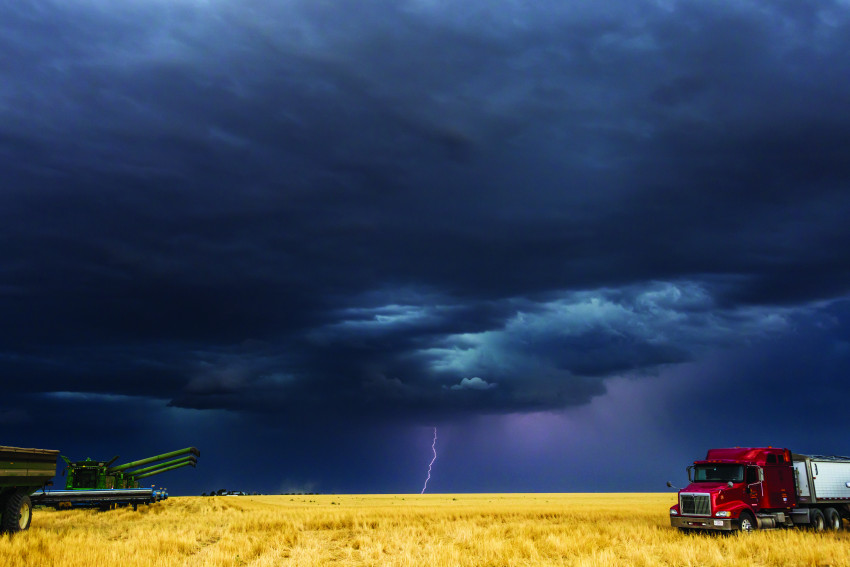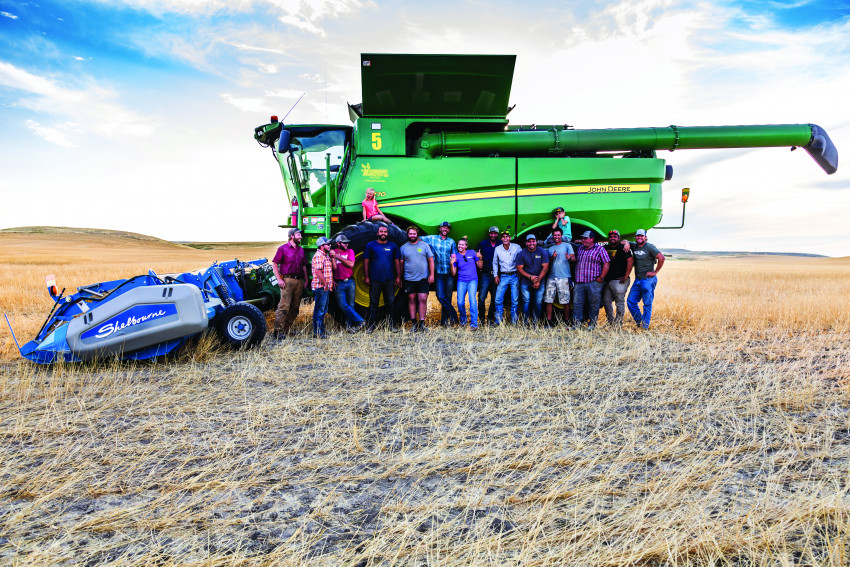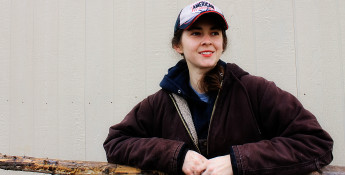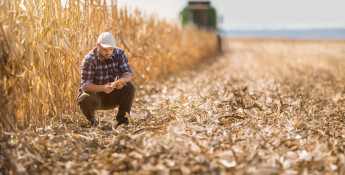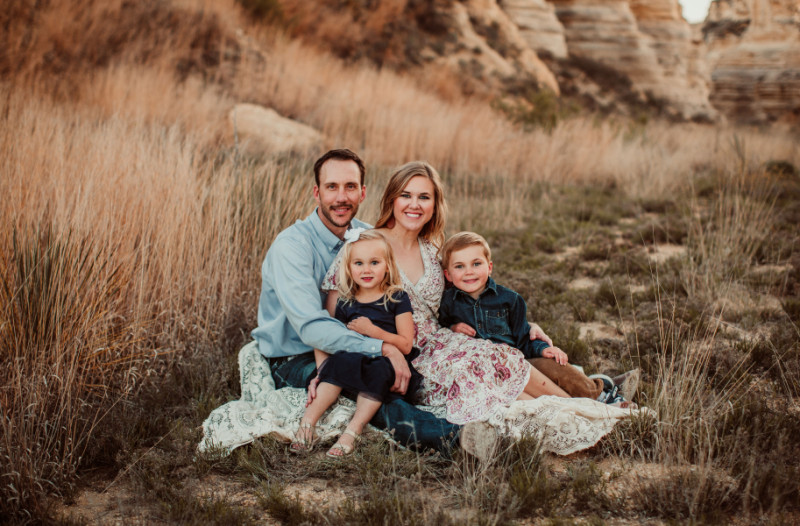By Greg Doering on May 5, 2021
Harvest Chasers
From Texas to Montana, a Kansas family experiences the highs and lows of custom harvesting

For most farmers, harvest marks the end of a journey of planning, planting and caretaking. For Ryan and Laura Haffner, harvesting is the journey. The Hays-based couple operates High Plains Harvesting, chasing a river of ripening wheat each summer from Texas to Montana before returning closer to home to cut fall crops in western Kansas.
Ryan worked on harvest crews with his uncle and a neighbor throughout high school and college. He had settled into a corporate job after college and Laura was teaching when a new prospect changed their plans.
“We had just invested in cattle and a month or two later this opportunity came up,” Laura says. “We were expanding our farm operation, and we had the opportunity to purchase the crew. We bit off quite a lot right there.”
In 2013 the Haffners moved to Hays to be closer to their farming operation and Ryan quit his full-time job two years later to focus on the harvesting business.
“At that point we were fully committed,” he says.
Harvest starts in mid-May for the High Plains crew, and is usually done by early December, but as with most things in agriculture, weather dictates the schedule.
NO TYPICAL DAY
High Plains Harvesting is essentially a service business, allowing landowners to forgo the investment in combines, trucks and labor needed to bring in a crop. Custom cutters can also supplement farmers who don’t have the machinery to harvest their entire crop.
Like most farmers, the Haffners’ days vary based on the challenges they sometimes face, like not having enough workers, bad weather and equipment breakdowns. All of this can play out 1,000 miles or more away from home.
“For the most part, from the day we start until the day we’re done, it’s my job to have us a job,” Ryan says of his work to keep the crew busy. “Unless it’s raining, we’ve always got another field to go to.”
Last year the crew worked more than 40 days straight at one point, but rain can stop work for a week or more.
“If you’re on your own farm and it gets wet, you maybe chill out, and then you can tinker on something else,” Ryan says. “When it rains for us, we get our equipment ready and then we wait.”
Crew members will take advantage of weather breaks to find some entertainment, like hitting up the Grand Canyon in Arizona, visiting Devil’s Tower in Wyoming or maybe renting a boat in Montana.
“When it’s time to work, we work, and if it’s time to have fun, we try to have fun,” Laura says. In many ways the Haffners’ success doesn’t come from planning, rather it’s their ability to be flexible in the face of constant upheaval.
“You have a plan but that plan changes 18 times a day,” Laura says. “You’re at the mercy of the weather, God and your customers.
LIFE ON THE RUN
While the days are long and varied, nights on “the run” are spent in campers. Rolling bunkhouses with communal living space and bathroom facilities house up to eight of the crewmembers while the Haffners hunker down in their own camper.
“We did have corporate jobs. Did I mention that?” Ryan quips about life on the road. But there are advantages.
“There are some days I ask, ‘What are we doing out here and why are we risking everything?’” Laura says. “And then we’re out there traveling, and you see and meet so many people. When you’re in Montana and you’re staying at this huge farm, you can’t even describe it. It’s just a feeling, to experience the beauty and the scale.”
HIRED HELP
At any given time, the Haffners employ between 12 and 24 people on their crew. The hired hands help with every aspect of harvest, from driving combines and steering grain carts to delivering the grain to storage facilities with semi-trucks.
While hiring local workers would be ideal, there’s a limited pool of people willing to take a job that lasts for six months, requires extensive travel and has limited opportunity to spend time with family members.
“Trying to find people who understand and want to go on this adventure has become increasingly difficult,” Laura says. “That’s a universal problem across the harvest industry as a whole. So we turn to programs like the H-2A to find legal employees who are willing to come from across the world.”
The H-2A program allows employers like the Haffners to bring in foreign workers on temporary visas to fill out their harvest crew. The process to hire this year’s workers started before the end of harvest in 2020. The Haffners have to line up paperwork with various federal agencies, identify potential workers and have them apply for an H-2A visa at a U.S. embassy or consulate before they can seek admission through the U.S. Customs and Border Control.
In addition to all the paperwork, employers pay for the travel and lodging of the temporary workers, plus a base pay rate set by the government. High Plains Harvesting also provides food for crewmembers.
“When I’m on the road, I try to make at least one hot meal a day for the crew,” Laura says. “That’s what I do for my family at home, so I try to keep it going on the road.”
Coolers with sandwich supplies are stocked at the field, though each worker is on their own to actually make it. The Haffners say that’s the easiest way to satisfy a group of up to two dozen that’s always on the go.
The H-2A program also is subject to events outside of the Haffner’s control, like COVID-19. Agriculture workers are designated as essential, which made it possible for High Plains to bring their workers over, but they came late and some had to fly on chartered flights.
“It was extremely pricey, but so is not going on the harvesting run when we have everything on the line,” Ryan says.
The pandemic made for a memorable harvest in other ways, too.
“This crew has had probably the best attitude we’ve ever had,” Laura says. “I think the aura of 2020 had something to do with that because we all needed each other in different ways.”
TOUGH START
The H-2A program allows for workers to return year after year, and High Plains Harvesting has some longtime employees who keep coming back. But each year includes new workers with varying degrees of experience, and Texas, where the season starts, offers a series of challenges with small fields, fence lines and even some oil equipment as potential hazards.
“We start off in some of our most difficult cutting of all, but by the time we get to Kansas, we’re a well-oiled machine,” Ryan says. “In Texas we might take the header off three times a day. If you’re running five combines, I get to take off 15 headers that day. It’s just a lot of work getting started.”
The tough conditions make for a fast learning curve and help the workers bond quickly, which is another part of the adventure.
“We’ve had some real young members at times — to see how they grow over the season is really cool,” Laura says. “The relationship side is really, really special.”
It’s also an experience the Haffners treasure with their two children, who have grown up tracking the wheat harvest alongside their parents, seeing a world of county festivals, museums and parks between fields.
“I think they think it’s amazing,” Ryan says of the family’s semi-nomadic lifestyle.
“They don’t know anything different,” Laura says. “They meet people from all over the world. I didn’t have that as a kid.”
FINISHING STRONG
Most of their work in the fall is about one to two hours west of their home in Hays, but it’s also the time when work ramps up for the crew — because corn produces more bushels per acre than wheat.
Wheat was once the main crop custom crews harvested, but those acres are becoming smaller and smaller as technology has sprouted new varieties of corn that are more drought tolerant so they can be grown in soil once dominated by wheat. Fall crops now account for about one-third of the Haffners’ business.
“Fall harvest is a big deal for us now,” Ryan says. “Western Kansas is just not like it used to be. My dad had never grown corn until Laura and I did in 2009. The last several years we’ve been 100 percent corn.”
Even though the work and crew grow in size for the fall harvest, there’s comfort in being close to the end and close to home.
“We’re like 1,300 miles away at our furthest field,” Ryan says. “So being two hours away is pretty much home.”

